Benefits of Post Tensioning System
Post-tensioning is a highly efficient structural system that provides many benefits in a wide variety of construction, repair and rehabilitation applications. The efficiency of the system is due to the use of high strength steel materials, the flexibility of the steel materials used to give geometric shapes, the ability to utilize all structural sections, the ability to change the force and reinforcement to best resist the applied loads, and the ability to control the timing of the application of pre-tensioning to the structure.
Post-tensioning offers a perfect balance of two complementary materials in reinforced concrete. Concrete is very strong in compression and relatively weak in tension. The tensile strength of concrete is about 10% of its compressive strength. On the other hand, prestressing steel has a very strong tensile strength (270,000 psi / 1860 MPa for wire), which is about four times that of commonly used construction reinforcement. In structures, the compressive and tensile forces caused by various loads can best be resisted by a combination of Rebar and Wire Rope. This allows the resistance to tensile stresses in the reinforced concrete element in the structure to be as strong as its compressive strength.
Post-tensioning can be used in all types of reinforced concrete structures, from buildings, bridges, cylindrical structures, foundations, highway pavements, floor slabs and ground anchors. It is also widely used for rehabilitation and renovation applications.
Post-tensioning application has many benefits for the investor, the contractor, the country's economy and the environment.
The main ones are as follows; - Post-tensioning technology allows wide openings to be crossed without supports. - Much more functional and spacious structures can be obtained in terms of architecture. - In post-tensioning floor manufacturing, savings are made in concrete and iron to be used in floors due to the decreases in floor thicknesses. - Since the amount of carbon dioxide released into the nature for iron and concrete production is very high, it minimizes the damage given to nature by allowing less iron and concrete consumption. - Post-tensioning system provides savings in manufacturing time, general expenses and labor due to reaching high manufacturing speeds. - With low slab thicknesses, total building loads are significantly reduced, therefore the earthquake effect on the building in case of an earthquake is less. In this way, more earthquake-resistant buildings can be built. - Minimizing and controlling cracks formed in reinforced concrete elements is another important benefit. - In regions with Hmax limitation, it allows more floors to be obtained at the same height thanks to low slab thicknesses.


